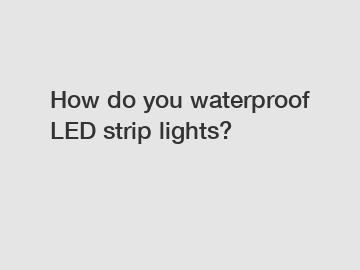Dec. 19, 2023
Lights & Lighting
SENBE Product Page
How do you waterproof LED strip lights?
LED strip lights are becoming increasingly popular for both indoor and outdoor lighting applications due to their flexibility, energy efficiency, and vivid color options. However, when using LED strip lights outdoors or in areas prone to moisture, it is crucial to ensure their waterproofing to maintain their longevity and functionality. In this article, we will explore effective methods to waterproof LED strip lights, their importance, and the impact of proper waterproofing on their performance.

Waterproofing LED strip lights is essential because LED strips are not naturally protected against moisture or water. Exposure to water can damage the internal components, leading to electrical shorts, corrosion, and overall failure. Therefore, taking necessary precautions to waterproof LED strip lights is imperative to ensure their durability and maintain their brightness over time.
There are several ways to waterproof LED strip lights. One common method is to use waterproof silicone coating. This involves applying a thin layer of silicone sealant over the entire LED strip, including the circuit board and solder points. The silicone forms a protective barrier, preventing water from seeping into the strips. Additionally, it helps to resist dust and UV radiation, extending the LED strip lights' lifespan. By using a waterproof silicone coating, you can ensure the LED strip lights remain fully functional and well-protected in damp or wet environments.
Another effective method is using waterproof LED strip light covers or casings. These covers are typically made of high-quality materials, such as PVC or silicone, and are designed to encapsulate the LED strips. They provide a physical barrier between the LED strip and external elements, effectively protecting them from water, dust, and other potential damages. LED strip light covers come in various forms, including transparent tubes or flexible silicone channels that encase the entire LED strip. They are easy to install and remove, allowing for flexibility in adapting the lighting design as needed.
Moreover, when waterproofing LED strip lights, attention must also be paid to the connectors and power supplies. These components are particularly vulnerable to moisture infiltration. To ensure complete waterproofing, it is advisable to use waterproof connectors and power supply junction boxes. These specialized accessories are designed to seal tightly, preventing water from entering the connections and compromising the LED strip lights' functionality.
Proper waterproofing of LED strip lights not only extends their lifespan but also enhances their safety. By preventing water from coming into contact with the electrical components, the risk of electrical shocks and fires is significantly reduced. This is particularly important in outdoor lighting applications, where the chances of exposure to rain or splashes are higher.
In conclusion, waterproofing LED strip lights is crucial to protect them from moisture and ensure their longevity and optimal performance. Whether through the application of a waterproof silicone coating or the use of waterproof covers and connectors, investing in proper waterproofing measures will significantly impact the durability and safety of LED strip lights. By considering the methods discussed in this article, you can enjoy the benefits of LED strip lights in various applications, both indoors and outdoors, without the worry of water damage or degradation over time.
Click here to get more.
Contact us to discuss your requirements of LED Neon Flex vs Conventional Lighting. Our experienced sales team can help you identify the options that best suit your needs.
Previous: Chinese Explosion Proof: Are State-of-the-Art Technologies Making Fireworks Obsolete?
Next: BGC401 Lighting: Ultimate Guide to Mastering Brilliant Illumination for Any Space
If you are interested in sending in a Guest Blogger Submission,welcome to write for us!
All Comments ( 0 )